Introduction
You pull back your bedsheets to climb into bed, and there they are—tiny black bugs crawling across your mattress or scurrying into the seams. Your heart races. Are these bed bugs? Should you panic? Will you need to throw out your entire bed? The discovery of small black bugs in bed is both alarming and confusing, triggering immediate concerns about hygiene, health, and the daunting prospect of a pest infestation.
Here’s the good news: most tiny black bugs found in bedrooms are NOT bed bugs. While that distinctive reddish-brown pest gets all the attention (and inspires the most fear), numerous other small insects can take up residence in your sleeping space—and most are far less problematic than their notorious cousin. However, proper identification is crucial because different bugs require different treatment approaches, and misidentification can lead to wasted time, money, and unnecessary stress.
The most common tiny crawling insects on mattress surfaces include carpet beetles, booklice, spider beetles, and occasionally fleas—each with distinct characteristics, behaviors, and removal strategies. Some are simply nuisance pests that wandered in from elsewhere in your home, while others may indicate underlying issues like excess humidity, fabric debris, or food sources that need addressing.
In this comprehensive guide, you’ll learn exactly how to identify the bed bedroom little tiny black bugs in house you’re dealing with, understand what attracted them to your sleeping space, assess whether they pose any health risks, and implement effective removal and prevention strategies. Whether you’re dealing with harmless fabric scavengers or a pest that requires immediate action, you’ll gain the knowledge to address the situation confidently and restore peace of mind to your bedroom sanctuary.
Identifying Common Tiny Black Bugs Found in Bedrooms
Accurate identification is your first and most important step. Let’s examine the most common small black bugs in bed and how to distinguish them from one another.
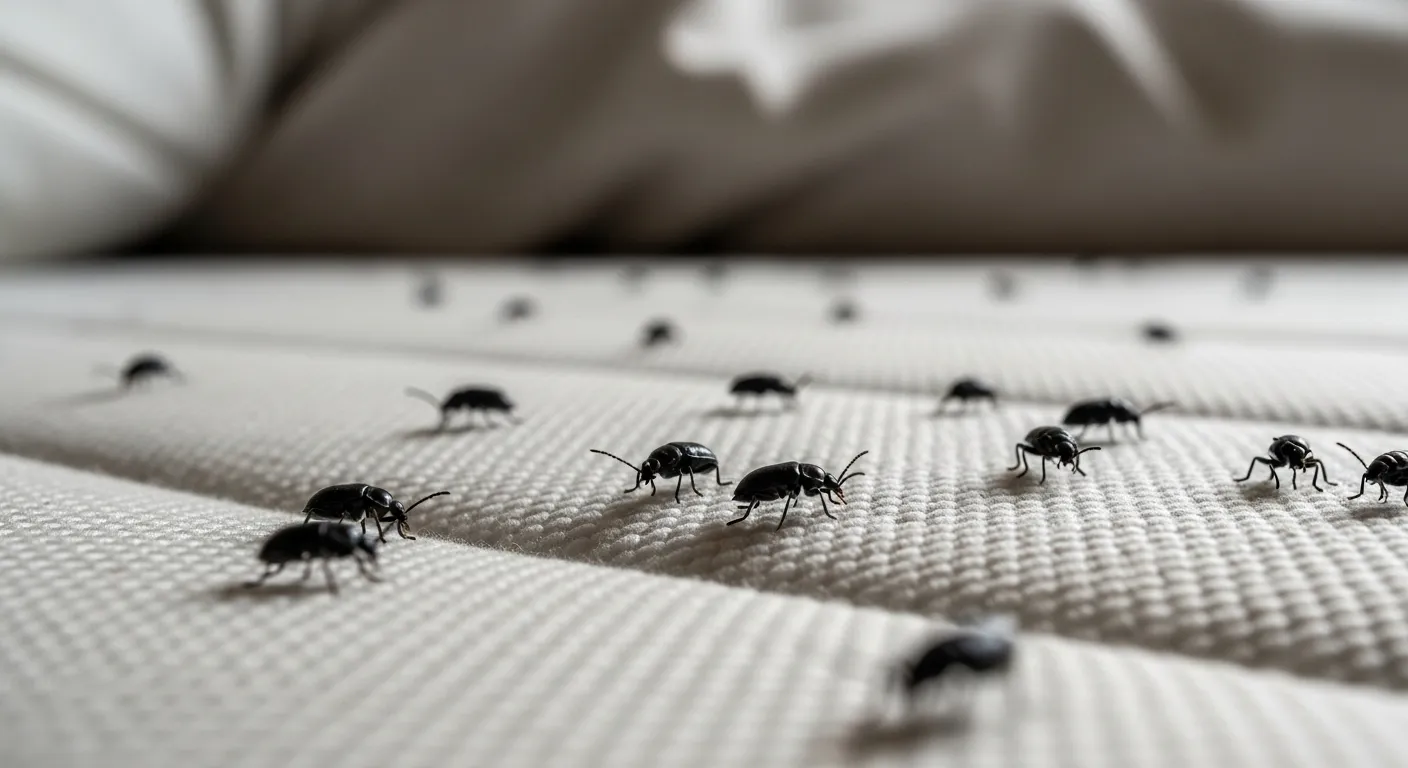
Carpet Beetles: The Most Common Bedroom Bug Culprit
Appearance and Size:
Carpet beetles are the usual suspects when homeowners discover tiny black bugs in their bedrooms.
Adult Carpet Beetles:
- Size: 1/8 to 3/16 inch long (2-5mm)
- Color: Black, brown, or mottled with white, orange, or yellow scales
- Shape: Oval, slightly rounded body
- Distinguishing features: Some species have patterned scales creating a speckled appearance
Carpet Beetle Larvae (Often Mistaken for the Adults):
- Size: 1/4 to 1/2 inch long (4-8mm)
- Appearance: Fuzzy, bristly, carrot-shaped body
- Color: Brown, tan, or striped
- Key identifier: Covered in distinctive bristle-like hairs
- More common: You’re more likely to see larvae than adults in bedding
Behavior Patterns:
What They Do:
- Feed on natural fibers (wool, silk, fur, feathers)
- Also consume dead insects, lint, hair, and food debris
- Adults are attracted to light and flowers
- Larvae avoid light, hiding in dark fabric folds
- Slow-moving, don’t fly away quickly
Where You’ll Find Them:
- In mattress seams and crevices
- Under beds and furniture
- In closets near wool clothing
- Around baseboards
- In carpet edges and under rugs
Do Carpet Beetles Bite?
Contrary to common belief:
- Adult carpet beetles do NOT bite humans
- Larvae do NOT bite
- Skin irritation sometimes reported is actually from:
- Contact dermatitis from larval bristles
- Allergic reactions to shed skins and feces
- Misattribution (bites from other sources blamed on beetles)
Why They’re in Your Bed:
Carpet beetles in bed are typically scavenging:
- Dead skin cells (we shed constantly)
- Hair and pet hair
- Food crumbs from eating in bed
- Natural fiber bedding materials
- Dust and lint accumulation
Booklice (Psocids): The Humidity-Loving Tiny Insects
Appearance and Characteristics:
Booklice in bedding indicate moisture issues rather than uncleanliness.
Physical Description:
- Size: Extremely small, 1/16 inch or less (1-2mm)
- Color: Translucent white, gray, or light brown
- Appearance: May look more gray than black unless clustered
- Shape: Soft-bodied, somewhat elongated
- Wings: Usually wingless (though some species have wings)
Behavior:
What Makes Them Unique:
- Move quickly when disturbed
- Often found in groups or clusters
- Active in humid conditions
- Feed on mold, fungi, and microscopic organic matter
- Don’t bite, don’t damage fabric
Where They Appear:
- On windows with condensation
- In bathrooms and laundry rooms
- In books, papers, and cardboard
- In bedding if humidity is high and mold present
- Around leaky pipes or damp walls
Why They’re Called “Booklice”:
Despite the name:
- Not actually lice at all
- Don’t parasitize humans or animals
- Called “book” lice because often found in old, damp books
- Feed on microscopic mold growing on paper and paste
Humidity Connection:
Booklice presence indicates:
- Relative humidity above 50-60%
- Potential mold growth (even if not visible)
- Poor ventilation
- Water intrusion or leaks
- Need for dehumidification
Bed Bugs vs. Bed Bug Lookalikes
Why Proper Identification Matters:
Bed bugs require professional extermination and are far more serious than carpet beetles or booklice. Here’s how to tell them apart.
Actual Bed Bugs:
Appearance:
- Size: 1/4 inch long (5-7mm) – about size of an apple seed
- Color: Reddish-brown (not black), darker after feeding
- Shape: Flat, oval, wingless
- Nymphs: Smaller, lighter colored, but still reddish-brown tint
Behavior and Evidence:
- Leave dark fecal spots on bedding (blood digestion)
- You’ll find cast skins (exoskeletons)
- Hide in mattress seams, box springs, headboards
- Active at night, bite exposed skin
- Bites appear in lines or clusters
- Leave blood spots on sheets
Key Difference:
If your bugs are:
- Truly black (not reddish-brown): NOT bed bugs
- Found crawling openly in daylight: Probably NOT bed bugs
- Causing no bites: Likely NOT bed bugs
- Very small (under 1/16 inch): Probably NOT adult bed bugs
Common Bed Bug Lookalikes:
Several insects get mistaken for bed bugs:
Spider Beetles:
- Small, round body
- Long legs
- Reddish-brown to black
- Actually beneficial (eat other pests)
Carpet Beetle Larvae:
- Fuzzy appearance
- Larger than bed bugs
- Move more slowly
- Don’t bite
Bat Bugs:
- Almost identical to bed bugs
- Only present if bats in attic/walls
- Require professional identification
Fleas: The Jumping Pest
Identifying Fleas in Mattress:
If you have pets, fleas are a possibility.
Physical Characteristics:
- Size: 1/16 to 1/8 inch (1.5-3mm)
- Color: Dark brown to black
- Shape: Laterally compressed (flat side-to-side)
- Key feature: Powerful jumping ability
Behavior:
How to Identify Flea Activity:
- Jump when disturbed (carpet beetles don’t jump)
- Found on pets’ bedding especially
- Leave behind “flea dirt” (black specks that turn red when wet – digested blood)
- Bites typically on ankles and lower legs
- More active on humans when pets are away
Flea vs. Carpet Beetle:
Fleas:
- Jump rapidly
- Bite humans and animals
- Leave flea dirt
- Associated with pets
Carpet beetles:
- Crawl slowly
- Don’t bite
- No flea dirt
- Not associated with pets particularly
Other Small Black Bugs That Might Appear in Bedrooms
Drugstore Beetles:
- Round, brown to black
- 1/10 to 1/8 inch long
- Feed on stored foods and medications
- Indicate food source nearby
Foreign Grain Beetles:
- Extremely tiny (1/16 inch)
- Reddish-brown to black
- Feed on mold in damp grain
- Indicate moisture and mold issues
Springtails:
- Tiny (1/16 inch or less)
- Usually white or gray, but appear dark in groups
- Jump using tail-like appendage
- Indicate severe moisture problem
How to Properly Inspect Your Bedroom for Insect Identification
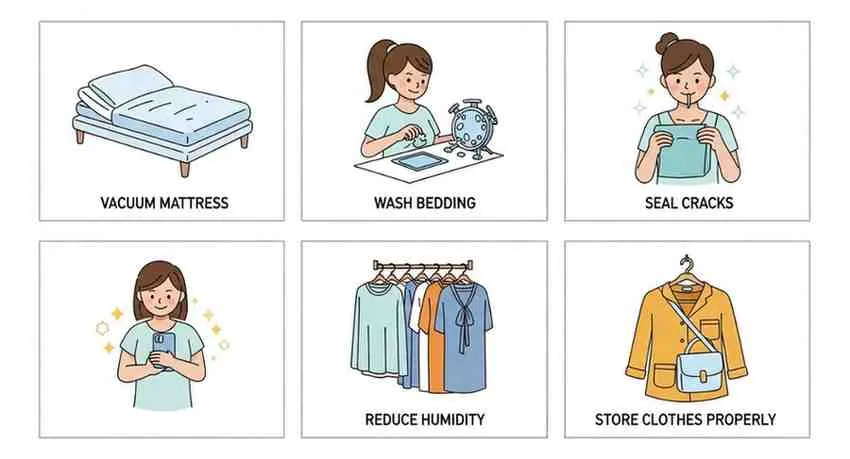
Accurate identification requires systematic inspection. Here’s how to conduct a thorough examination.
Inspection Tools and Techniques
What You’ll Need:
- Flashlight: Bright LED flashlight for seeing into crevices
- Magnifying glass: For close examination of tiny insects
- White paper or cloth: Place bugs on white surface for better visibility
- Clear tape: Capture specimens for identification
- Phone camera: Take macro photos for later comparison or expert consultation
Capture Method:
To safely capture for identification:
- Use clear tape to gently pick up bug
- Fold tape over to trap insect
- Stick to white paper for examination
- Take to pest control professional if uncertain
Systematic Bedroom Inspection Process
Step 1: Mattress Examination
What to Check:
- All seams and piping around mattress edges
- Tag area (bugs often hide here)
- Underneath mattress handles
- Bottom of mattress (flip it over)
- Box spring fabric, especially corners and stapled areas
What You’re Looking For:
- Live insects of any size
- Cast skins or shed exoskeletons
- Fecal spots (look like pepper specks or small blood stains)
- Eggs (tiny, white, rice-shaped)
Step 2: Bed Frame and Headboard
Inspect:
- All joints and crevices
- Screw holes and bolt areas
- Back of headboard
- Under platform supports
- Inside hollow bed frame components
Step 3: Bedding and Linens
Check:
- Between sheets and mattress pad
- Pillowcase seams
- Comforter or duvet folds
- Under bed skirt
- In laundry basket with dirty linens
Step 4: Surrounding Areas
Don’t Forget:
- Under the bed (use flashlight)
- Behind nightstands
- In nightstand drawers
- Along baseboards
- Behind pictures or wall décor
- In closet (especially near natural fiber clothing)
- Curtains and window sills
Documenting Your Findings
Recording Information:
For accurate identification and treatment:
Document:
- Number of bugs found
- Specific locations
- Time of day spotted
- Bug behavior (jumping, crawling speed, flying)
- Any patterns or trails
Photography Tips:
- Take photos next to ruler or coin for size reference
- Use macro mode on phone camera
- Get multiple angles
- Photograph location where found
- Save photos with date/time stamps
Why Documentation Matters:
If you need professional help:
- Pest control companies can prepare more accurately
- You can email photos for preliminary identification
- You have evidence of infestation severity
- You can track whether problem is improving
Root Causes: Why You Have Tiny Black Bugs in Your Bedroom
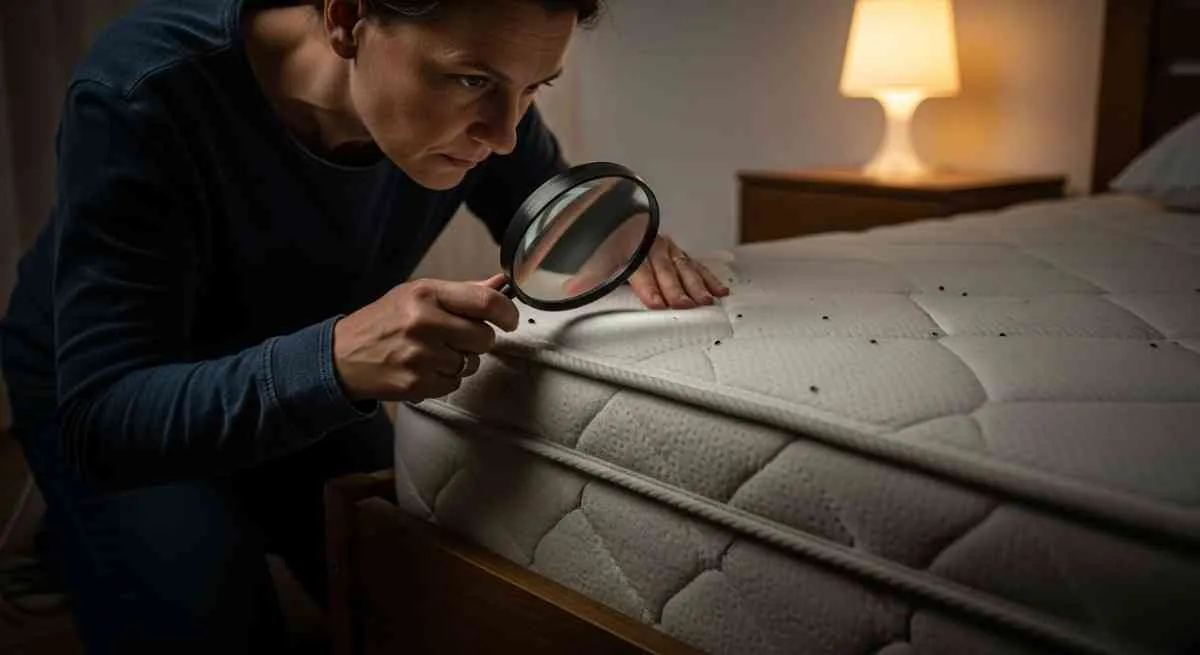
Understanding what attracted these insects helps prevent recurrence. Let’s examine the common environmental factors and sources.
Environmental Factors Attracting Indoor Black Bugs
Humidity and Moisture Issues:
Excess moisture creates ideal conditions for many insects.
Humidity-Loving Bugs:
- Booklice thrive above 50% relative humidity
- Springtails indicate very damp conditions
- Mold-eating beetles follow moisture
Common Moisture Sources:
- Leaky pipes behind walls
- Condensation on windows
- Bathroom humidity spreading to adjacent rooms
- Damp basements below bedroom
- Recent flooding or water damage
- Humidifiers set too high
- Poor ventilation
Solutions:
- Use dehumidifier (aim for 30-50% relative humidity)
- Fix any leaks promptly
- Improve ventilation
- Use exhaust fans
- Address basement moisture
Food Sources in Bedrooms:
Even tiny food debris attracts insects.
What Attracts Bugs:
- Crumbs from eating in bed
- Food residue on hands before bed
- Pet food bowls in bedroom
- Old food forgotten under bed
- Candy or snack wrappers in nightstand
- Spilled drinks on carpet
Natural Food Sources:
- Dead skin cells (constant)
- Hair (human and pet)
- Dead insects in window sills
- Dust and lint accumulation
- Natural fiber textiles
Prevention:
- No eating in bed policy
- Regular vacuuming
- Wash bedding weekly
- Clean under bed monthly
- Remove clutter where debris accumulates
Fabric and Natural Fiber Accumulation:
Carpet beetles especially love natural materials.
Attractive Materials:
- Wool blankets or clothing
- Silk bedding or garments
- Fur or feather items
- Leather items
- Natural fiber carpets
- Upholstered furniture with natural stuffing
Risk Factors:
- Storing woolens improperly
- Old natural fiber items deteriorating
- Forgotten clothes in closet corners
- Natural fiber area rugs
- Down comforters and pillows
How Bugs Enter Your Home and Bedroom
Primary Entry Points:
Through Open Windows and Doors:
- Attracted to indoor lights at night
- Flying species (adult carpet beetles)
- Carried on breeze
- Following scent of food or pheromones
Gaps and Cracks:
- Spaces around window frames
- Gaps under doors
- Cracks in baseboards
- Holes around utility penetrations
- Damaged window screens
- Gaps around pipes
Brought Inside:
Via Infested Items:
- Used furniture (major source)
- Secondhand clothing
- Thrift store textiles
- Packages and deliveries
- Luggage after travel
- Moving boxes from storage
On Pets:
- Fleas riding on dogs and cats
- Beetles in pet bedding
- Insects from outdoor pets entering
- Veterinary clinic transfers
From Outdoors:
- On clothing after being outside
- In firewood brought inside
- On plants brought indoors
- Through attic from outdoors
- From attached garage
From Other Home Areas:
Bugs spread between rooms:
- From infested attic crawling down
- From damp basement moving up
- From pantry (if drugstore beetles)
- From other bedrooms
- Through HVAC ducts
Specific Scenarios and Risk Factors
Recent Changes That Increase Risk:
You’re More Likely to See Bugs After:
Moving or Buying Used Furniture:
- Old mattresses are high risk
- Upholstered chairs can harbor larvae
- Wooden furniture might have beetles
- Always inspect thoroughly before bringing inside
Seasonal Changes:
Spring and Summer:
- Adult carpet beetles emerge and fly indoors
- Increased humidity in many regions
- More bugs active generally
- Windows open more frequently
Fall:
- Insects seeking indoor winter shelter
- Heat turning on attracts bugs to warmth
- Humidity changes
- Stink bugs and cluster flies (though not usually in beds)
After Water Damage:
- Flooding creates ideal conditions
- Mold growth attracts booklice
- Damp materials attract beetles
- Moisture-loving insects multiply
Pet-Related Risks:
If You Have Cats or Dogs:
- Flea risk increases dramatically
- Pet hair accumulation feeds carpet beetles
- Pet bedding should be washed regularly
- Outdoor pets bring in more insects
Storage and Clutter Issues:
Conditions That Increase Infestations:
- Boxes under bed (creates hiding spots)
- Cluttered closets with old textiles
- Stored woolens not in sealed containers
- Old papers and cardboard
- Rarely moved furniture
- Neglected corners and spaces
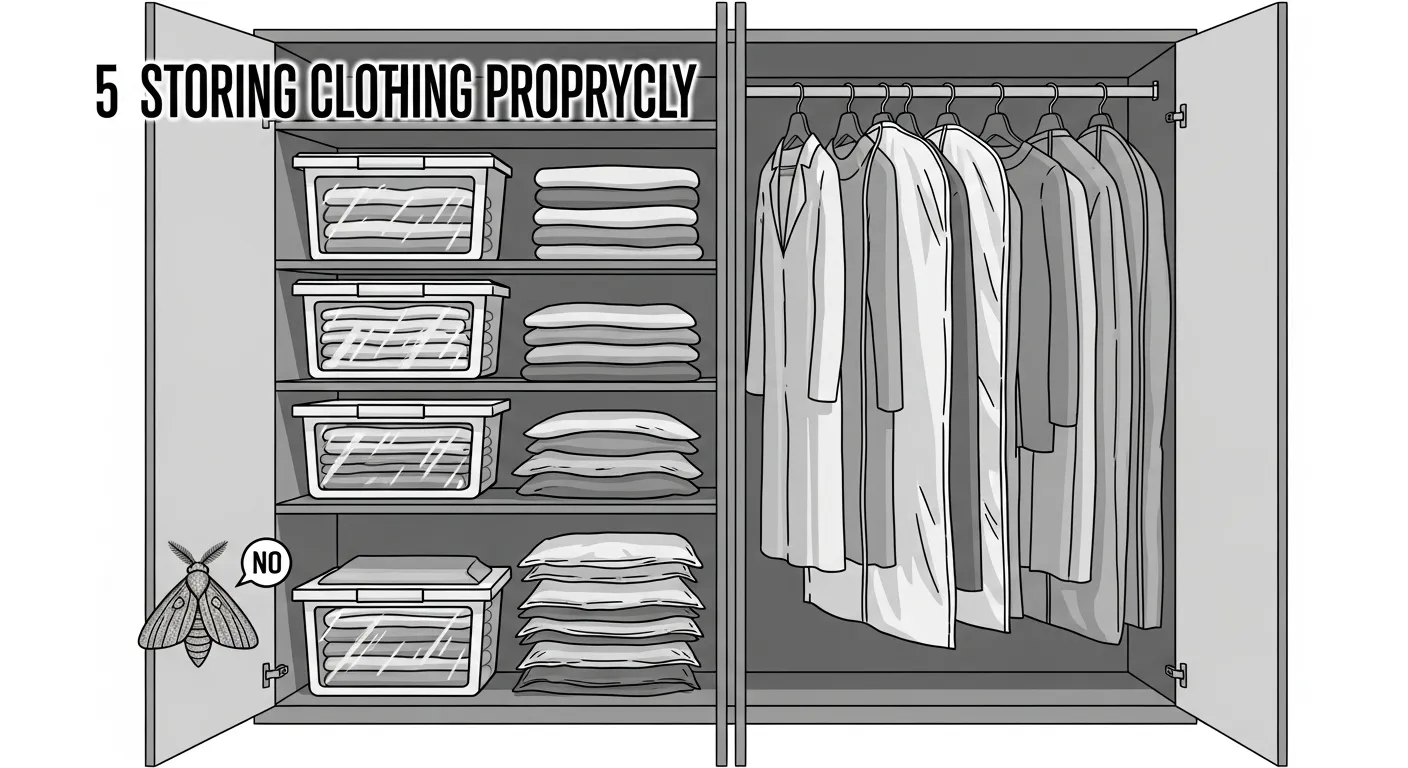
Health and Safety Considerations
Before panicking, understand the actual risks these tiny insects pose.
Are These Bugs Harmful or Just Nuisance Pests?
The Good News:
Most bed bedroom little tiny black bugs in house are not dangerous to humans.
Carpet Beetles:
- Health risk: Minimal to none
- Biting: Do not bite
- Allergies: Some people experience contact dermatitis from larvae bristles
- Fabric damage: YES – this is the main concern
- Disease transmission: None
Booklice:
- Health risk: None
- Biting: Do not bite
- Allergies: Very rare
- Property damage: Feed on mold, not really damaging
- Disease transmission: None
- Main issue: Indicator of moisture/mold problems
Spider Beetles:
- Health risk: None
- Biting: Do not bite
- Property damage: Can damage stored foods
- Disease transmission: None
- Actually beneficial: Some species eat other pests
Foreign Grain Beetles:
- Health risk: None
- Biting: Do not bite
- Property damage: Contaminate foods
- Disease transmission: None
The Exceptions:
Fleas:
- Do bite humans and pets
- Can transmit diseases (rare in modern developed countries)
- Cause allergic reactions in sensitive individuals
- Require prompt treatment
Bed Bugs (if that’s actually what you have):
- Do bite and feed on blood
- Cause itching, sleep disturbance, anxiety
- Don’t transmit diseases (despite biting)
- Require professional extermination
Potential Allergic Reactions and Skin Irritation
Contact Dermatitis from Carpet Beetles:
Some individuals experience:
- Itchy, red skin after contact with larvae
- Small bumps or welts
- Reactions to shed skins and feces
- Respiratory symptoms if many beetles present
Characteristics:
- Not a true bite
- Irritation from contact with larval bristles
- Can be mistaken for bites
- Washes off with soap and water
Who’s at Risk:
- People with sensitive skin
- Those with existing allergies
- Children (more sensitive generally)
- Anyone with compromised immune systems
Treatment:
- Wash affected area with soap and water
- Anti-itch cream or hydrocortisone
- Antihistamine if needed
- See doctor if severe or persistent
Mold and Booklice Connection:
Indirect Health Concerns:
Booklice themselves are harmless, but their presence indicates:
- Mold growth (which CAN cause health issues)
- Poor air quality
- Potential respiratory irritants
- Need for mold remediation
Mold Health Effects:
- Allergies and asthma triggers
- Respiratory irritation
- More serious in sensitive individuals
- Should be addressed regardless of bugs
Differentiating Harmless Insects from Bed Bugs
Why Correct Identification Is Critical:
If You Mistake Harmless Bugs for Bed Bugs:
- Waste money on unnecessary professional treatment
- Use harsh chemicals unnecessarily
- Experience unnecessary anxiety
- Miss the actual issue (moisture, cleanliness, etc.)
If You Mistake Bed Bugs for Harmless Bugs:
- Infestation worsens significantly
- Bugs spread to other rooms
- More expensive treatment needed later
- Continue being bitten
- Potential spread to visitors’ homes
Red Flags That Suggest Actual Bed Bugs:
Seek Professional Inspection If:
- You wake with new, itchy bites regularly
- Bites appear in lines or clusters
- You find dark fecal spots on bedding
- Bugs are reddish-brown (not black)
- You see shed exoskeletons
- You detect sweet, musty odor
- Multiple bugs found in mattress seams
Peace of Mind Indicators (Probably NOT Bed Bugs):
You’re Likely Dealing with Something Else If:
- Bugs are truly black, not brown-red
- No bites appearing on your body
- Bugs found mainly in one area (like window)
- Bugs very tiny (under 1/8 inch)
- Bugs jump (fleas) or are fuzzy (carpet beetle larvae)
- Problem started after introducing specific item
When in Doubt:
- Capture specimen in clear tape
- Take to local extension office
- Contact pest control for free inspection
- Many companies offer free bed bug inspections
- Peace of mind worth the cost of professional ID
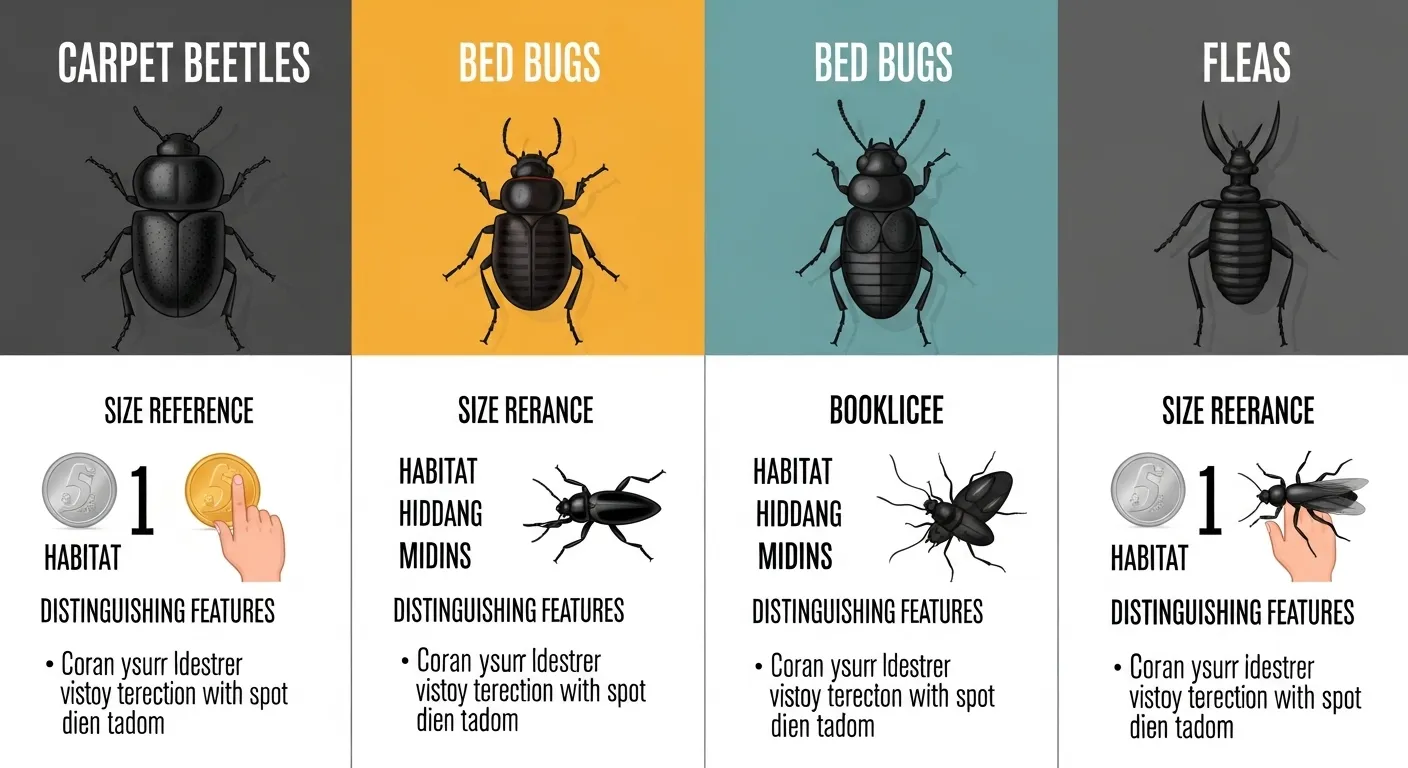
Effective Removal and Prevention Strategies
Once you’ve identified your tiny black bugs, implement appropriate removal and prevention measures.
Immediate Cleaning and Vacuuming Techniques
The First Line of Defense:
Thorough cleaning removes most small black bugs in bed and their food sources.
Step-by-Step Cleaning Protocol:
1. Strip and Launder All Bedding:
Wash in hot water:
- All sheets, pillowcases, mattress covers
- Blankets, comforters, duvet covers
- Bed skirts and decorative pillows
- Temperature: Hottest water fabric allows (130°F+ kills most insects)
- Dry: High heat cycle for at least 30 minutes
- Frequency: Weekly until problem resolved, then every 1-2 weeks
Items that can’t be washed:
- Place in sealed plastic bags
- Put in freezer for 72 hours (kills insects at all life stages)
- Alternatively: dry clean
- Or seal in bags for 2-3 weeks (starves insects)
2. Vacuum Thoroughly and Strategically:
Mattress vacuuming:
- Use crevice tool for all seams
- Vacuum entire mattress top and bottom
- Pay special attention to piping and edges
- Vacuum box spring thoroughly
- Use upholstery attachment for broad surfaces
Bedroom vacuuming:
- All carpet edges and corners
- Under and around bed
- Baseboards completely
- Inside closets
- Under furniture
- Window sills and tracks
- Behind and under radiators/vents
Critical step:
- Immediately remove vacuum bag/empty canister outside
- Seal in plastic bag before disposing
- Clean vacuum filters
- Prevents re-infestation from vacuum
3. Steam Cleaning (Optional but Effective):
For severe infestations:
- Rent or buy steam cleaner
- Steam kills insects and eggs on contact
- Use on mattress, box spring, carpet
- Temperature: Maintain 130°F+
- Let everything dry completely (prevents mold)
Mattress Protection and Care
Encasements and Covers:
Invest in Quality Mattress Encasements:
Benefits:
- Traps any bugs inside mattress (they eventually starve)
- Prevents new bugs from entering
- Protects against dust mites too
- Makes inspection and cleaning easier
- Allergen barrier
What to Look For:
- Zippered closure
- Bed-bug-proof certified
- Breathable fabric (not plastic sheet)
- Covers entire mattress including zipper
- Also get box spring encasement
Cost: $30-100 depending on size and quality
Mattress Maintenance Schedule:
Weekly:
- Vacuum mattress surface
- Check for new bug signs
- Wash all bedding
Monthly:
- Vacuum mattress seams thoroughly
- Vacuum box spring
- Inspect under bed
- Check encasement for tears
Seasonally:
- Consider professional deep cleaning
- Rotate mattress if applicable
- Deep vacuum bedroom
- Inspect and clean under/behind furniture
When to Replace Your Mattress:
Consider replacement if:
- Severe bed bug infestation (consult professional first)
- Mattress over 7-10 years old
- Structural damage providing bug hiding spots
- Persistent mysterious bites despite treatment
- Moldy or water-damaged
- You simply want peace of mind
Note: Most tiny black bugs don’t require mattress replacement – proper cleaning suffices.
Effective Pest Control Products
Natural and Chemical Options:
Diatomaceous Earth (DE):
How it works:
- Microscopic sharp particles damage insect exoskeletons
- Causes dehydration and death
- Non-toxic to humans and pets (food-grade DE)
- Effective against most crawling insects
Application:
- Sprinkle lightly in cracks and crevices
- Under bed perimeter
- Along baseboards
- Behind furniture
- Not on bedding where you sleep
- Use food-grade DE only indoors
Caution:
- Wear dust mask when applying (irritates lungs if inhaled)
- Keep pets away during application
- Vacuum up excess (thin layer is sufficient)
Boric Acid:
Effective for:
- Carpet beetles
- Many other household insects
- Long-lasting residual effect
Application:
- Light dusting in cracks, crevices
- Behind baseboards
- Under carpets edges
- Where pets and children cannot access
Safety:
- Toxic if ingested in quantity
- Keep away from pets and kids
- Not for use on bedding or sleeping surfaces
- Wear gloves when applying
Essential Oils and Natural Repellents:
Some evidence for repellent properties:
- Cedar oil (carpet beetles especially)
- Lavender oil
- Eucalyptus oil
- Peppermint oil
Usage:
- Add to cleaning solutions
- Spray diluted on baseboards (test first)
- Cedar blocks in closets
- Sachets in drawers
Reality check:
- May help repel, not eliminate
- Not as effective as proper cleaning
- Can be part of integrated approach
- Pleasant smell bonus
Commercial Insecticides:
For More Serious Infestations:
Options:
- Pyrethrin-based sprays (derived from chrysanthemums)
- Permethrin sprays
- Insect growth regulators
- Residual sprays for baseboards
Important considerations:
- Follow label directions exactly
- Keep pets and children away during treatment
- Ventilate well after application
- Don’t spray directly on bedding
- Focus on bug hiding spots, not sleeping surfaces
When to Call Professionals:
Hire pest control if:
- Infestation is severe or spreading
- You can’t identify the insects confidently
- DIY methods haven’t worked after 2-3 weeks
- You suspect bed bugs
- You have health concerns or allergies
- You want guaranteed elimination
Professional advantages:
- Accurate identification
- Appropriate treatment selection
- Commercial-grade products
- Treatment guarantee
- Safety expertise
Sealing Entry Points and Environmental Control
Exclusion: Keeping Bugs Out:
Window and Door Maintenance:
Seal gaps:
- Install or repair window screens (no tears or holes)
- Weather-stripping around doors
- Door sweeps on all exterior doors
- Seal gaps around window frames with caulk
- Ensure good fit when closed
Inspect regularly:
- Check screens before opening windows
- Replace damaged screens promptly
- Keep doors closed when possible
Structural Sealing:
Close Bug Entry Points:
- Caulk cracks in baseboards
- Seal gaps around pipes and utilities
- Fill holes in walls
- Repair damaged drywall
- Seal attic access points
- Check chimney for gaps
Materials:
- Silicone caulk for most applications
- Expanding foam for larger gaps
- Copper mesh for holes (prevents chewing through)
- Weather-resistant materials for exterior
Humidity Control:
Maintain Optimal Levels:
Target: 30-50% relative humidity
Methods:
- Dehumidifier in bedroom if needed
- Fix any leaks immediately
- Exhaust fans in bathrooms
- Open windows for ventilation (with screens)
- Don’t over-humidify in winter
- Address basement moisture
Monitor:
- Use hygrometer (humidity meter)
- Check bathroom and bedroom levels
- Adjust as needed seasonally
Clutter Reduction:

Minimize Bug Hiding Spots:
- Keep items off floor
- Store clothing in sealed containers
- Regular decluttering
- Don’t store boxes under bed long-term
- Keep closets organized
- Remove unnecessary textiles
Storage best practices:
- Plastic bins with tight lids (not cardboard)
- Cedar chests for woolens
- Vacuum-sealed bags for seasonal items
- Elevate storage off floor
- Regular inspection of stored items
Real-Life Scenarios and Success Stories
Understanding common situations helps you relate your experience and learn from others’ solutions.
Case Study 1: Carpet Beetles Misidentified as Bed Bugs
The Situation:
Sarah discovered several tiny black bugs crawling on her mattress and immediately panicked, convinced she had bed bugs. She prepared to throw out her expensive mattress and hire an exterminator.
The Investigation:
Before taking drastic action:
- Captured bug in tape for inspection
- Took macro photo on phone
- Researched online identification guides
- Compared to actual bed bug images
The Discovery:
Bugs were actually:
- Varied carpet beetles (adults)
- Also found fuzzy larvae in closet
- No bites reported
- Bugs were truly black, not reddish-brown
- Found in various locations, not concentrated in mattress seams
The Solution:
Sarah’s approach:
- Thoroughly vacuumed entire bedroom
- Washed all bedding in hot water
- Steam-cleaned carpet
- Decluttered closet and inspected woolens
- Found old wool blanket infested with larvae – discarded it
- Applied diatomaceous earth along baseboards
- Sealed cracks around baseboards
- Vacuumed weekly for 6 weeks
The Outcome:
“Within two weeks, I stopped seeing new beetles. After a month, they were completely gone. I saved thousands of dollars by correctly identifying the insects and using DIY methods instead of assuming bed bugs. The key was finding the source—that old wool blanket—and removing it.”
Key Lessons:
- Proper identification saves money and stress
- Most small black bugs are NOT bed bugs
- Finding and removing the source is critical
- Thorough cleaning usually works without harsh chemicals
Case Study 2: Booklice Indicating Moisture Problem
The Situation:
Mike noticed hundreds of tiny, almost microscopic bugs on his bedroom window sill and occasionally on his bed linens.
Initial Confusion:
- Bugs were so small they were hard to see individually
- Appeared as dark patches that moved when disturbed
- No bites or damage
- Mostly around window, but some near bed
Professional Identification:
Mike contacted local university extension office:
- Brought specimens in tape
- Identified as booklice (psocids)
- Told these indicated high humidity and possibly mold
Root Cause Discovery:
Investigation revealed:
- Window frame had minor leak
- Condensation accumulating regularly
- Humidity in bedroom measured 68%
- Black mold growing on window frame (hidden by curtain)
The Solution:
Mike’s multi-step approach:
- Address Moisture:
- Repaired window seal
- Purchased dehumidifier for bedroom
- Improved ventilation
- Eliminate Mold:
- Cleaned visible mold with bleach solution
- Repainted window frame with mold-resistant paint
- Removed and washed curtains
- Remove Bugs:
- Vacuumed window sills daily
- Reduced humidity to 45%
- Bugs disappeared within one week
The Outcome:
“The booklice were actually helpful—they alerted me to a moisture problem I didn’t know I had. Fixing the leak and controlling humidity solved both the bug problem and prevented potential mold health issues. The bugs haven’t returned in six months.”
Key Lessons:
- Booklice indicate moisture issues
- Addressing root cause (humidity) eliminates bugs
- Sometimes bugs alert you to bigger problems
- Dehumidification is critical in damp environments
Case Study 3: Flea Infestation from New Pet
The Situation:
Jennifer adopted a rescue dog and two weeks later found small black jumping bugs in her bed and on her carpet.
Quick Identification:
Distinctive features made identification easy:
- Bugs jumped when approached
- Dog was scratching constantly
- Found “flea dirt” (black specks) in dog’s bedding
- Bugs were dark brown/black, tiny, fast-moving
Comprehensive Treatment:
Jennifer’s approach required treating both pet and environment:
1. Pet Treatment:
- Veterinarian-prescribed flea treatment for dog
- Flea shampoo bath
- Flea collar
- Regular grooming checks
2. Home Treatment:
- Washed all bedding in hot water
- Vacuumed entire house thoroughly (every



